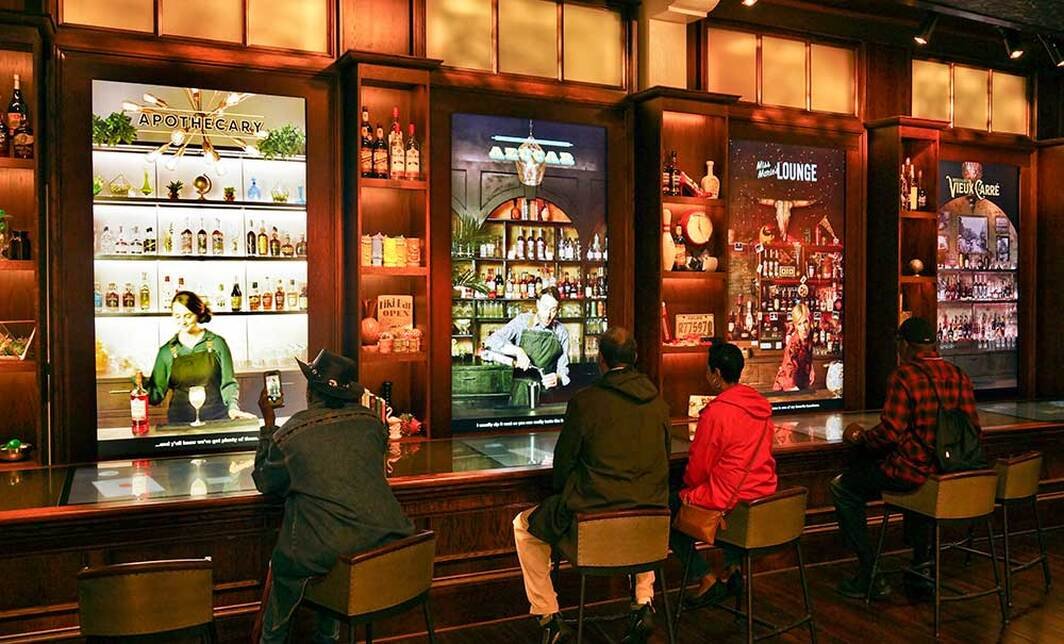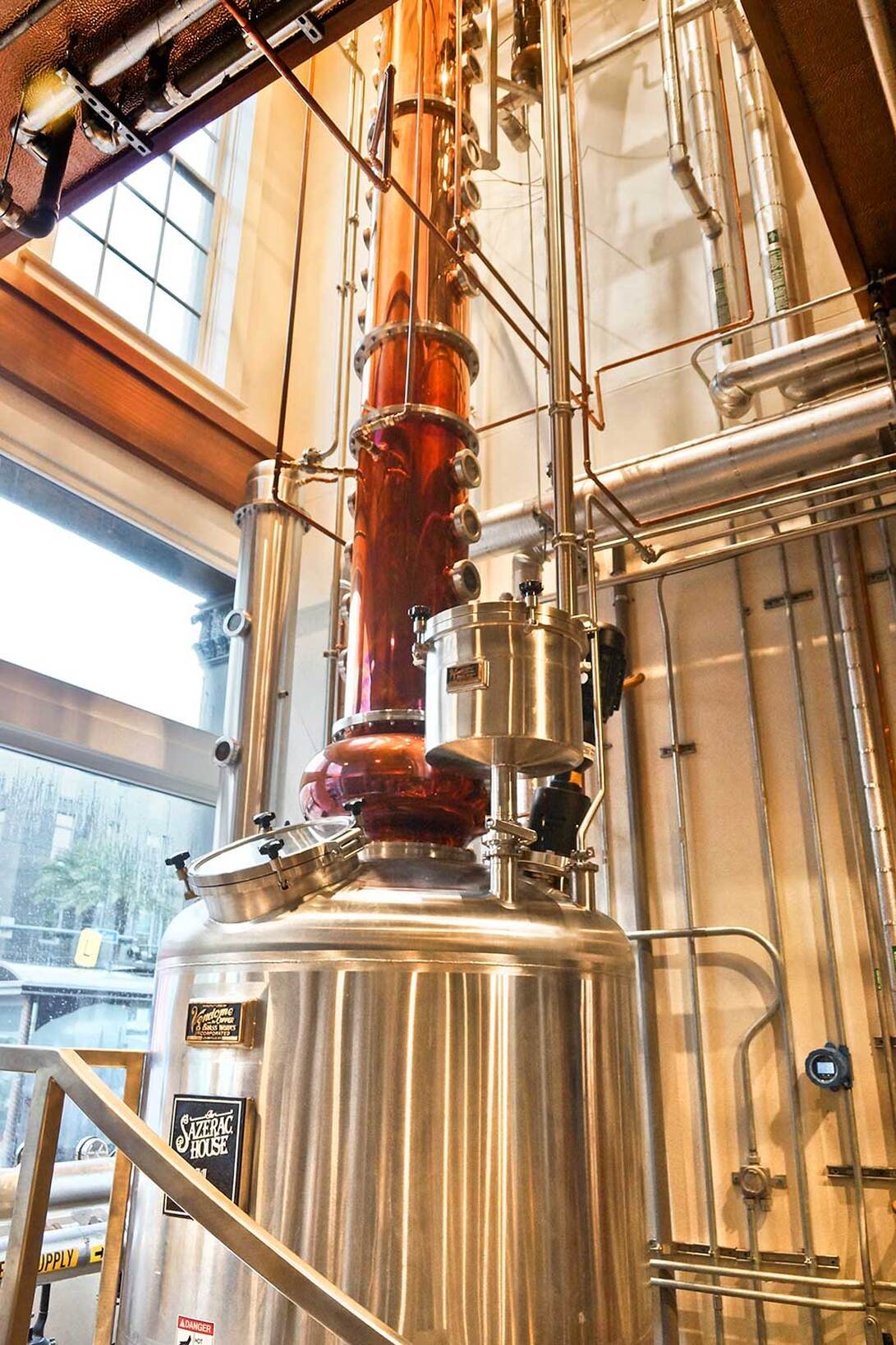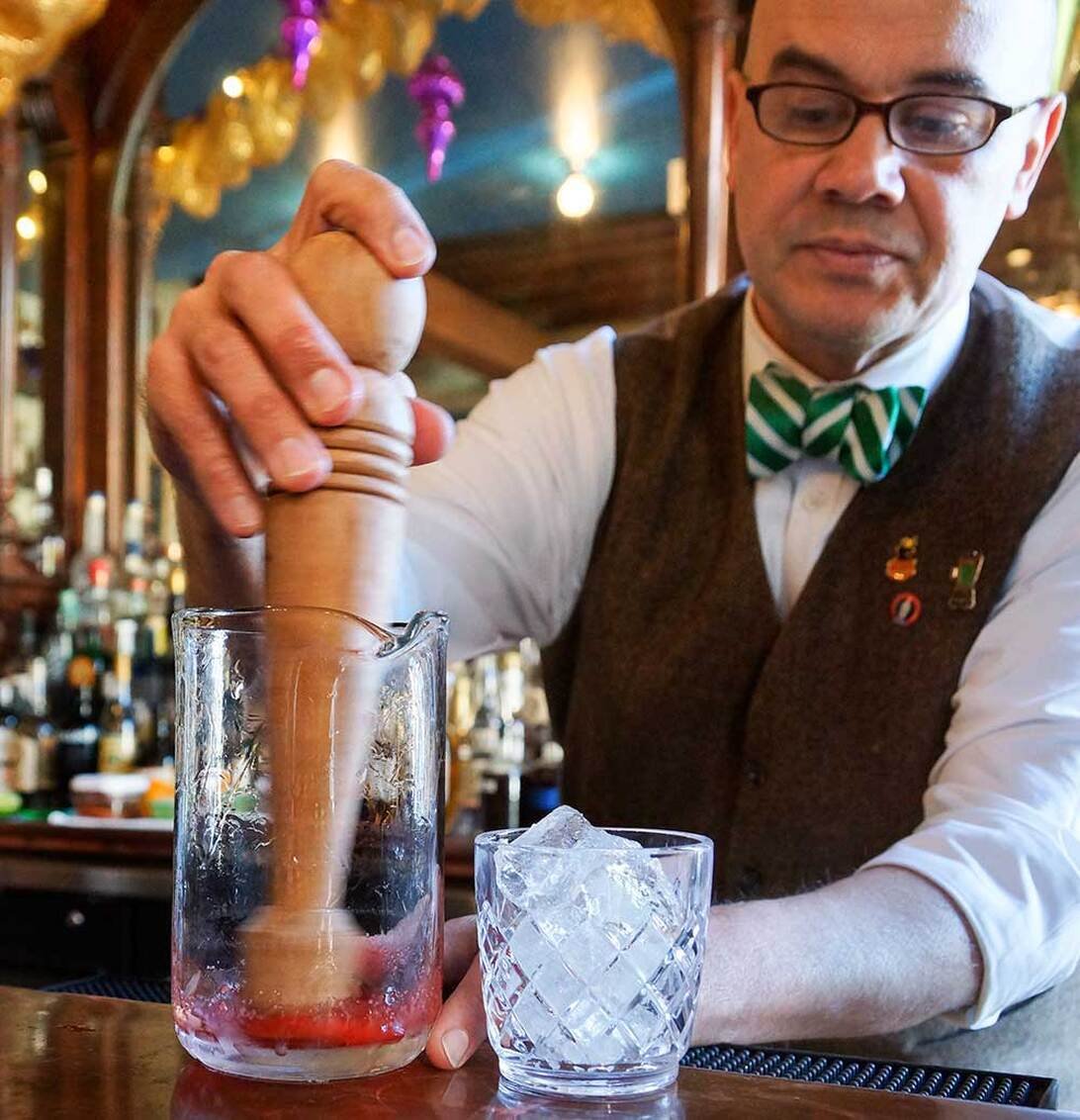Served Straight Up: The Sazerac
2/29/2020A trip to the new Sazerac House interactive museum and distillery leads to sampling the classic cocktail at five favorite French Quarter bars.
- story by Kim Ranjbar
- photos by Ellis Anderson
Sazerac. The mere name sounds jazzy and Southern.
This historic tipple is reputed to be the first true American “cocktail,” created right here in New Orleans in the 1830s by famed apothecary Antoine Amédée Peychaud, creator of Peychaud's Bitters, a crucial ingredient in any Sazerac worthy of the name.
Along with bitters, the original ingredients also included cognac - specifically Sazerac de Forge et Fils, hence the name - and absinthe. But a phylloxera infestation in the late 1800s devastated the French vineyards and made cognac too expensive, and absinthe was banned in the U.S. in 1912. So, rye whiskey replaced cognac. Absinthe was replaced with other anise-flavored liqueurs, notably Herbsaint, morphing the initial recipe into the cocktail we know and love today.
The Sazerac has had its moments on the Big Screen. Katherine Hepburn swilled a Sazerac in State of the Union (1949). The cocktail made a cameo in the Bond film Live and Let Die (1973). And there was the infamous scene in HBO's Treme (2011), when restaurant critic Alan Richman gets one thrown in his face. The Sazerac has made itself known worldwide, but in New Orleans it will always be the star.
In 2008, by a 62-33 vote, the Louisiana House of Representatives formally proclaimed the Sazerac the official cocktail of New Orleans. This past October, The Sazerac House, a museum and distillery, opened on the corner of Magazine and Canal streets right across from the French Quarter.
In a $50 million renovation, The Sazerac Company transformed an 1860s-era building (101 Magazine Street) into an interactive, immersive cocktail experience only a few hundred yards from where the Sazerac was born.
Among other activities, guests are invited to experience a 19th century French Quarter in a simulation of the original Sazerac House café and chat with virtual bartenders, learning how to mix behind the stick from the bartender's bible, Mr. Boston Official Bartender's Guide.
Virtual bartenders at Sazerac House
Delving into the deep roots of the cocktail culture in New Orleans and, more specifically, the history of the Sazerac family, aren't the only function of this five-story tribute to hootch. The Sazerac House also features a distillery that produces Sazerac Rye (of course) as well as Peychaud's Bitters.
With only five ingredients the Sazerac may seem simple, but inaccurate measurements and poor methodology can easily disrupt the harmonious balance of this elegant cocktail. Fortunately, there are bars and restaurants all over the city with talented bartenders who can execute a Sazerac with skill and ease. Below are only a few of our French Quarter favorites:
The Carousel Bar & Lounge
Easily one of the most famous spots to quaff in the French Quarter (if not the country) is the Carousel Bar. Located inside the Hotel Monteleone (214 Royal Street), this immensely popular bar which finishes a rotation every 15 minutes has been serving, and spinning, for over 70 years.
Not just a pretty face, the Carousel Bar is known for its classic cocktail program, headed by bartender Marvin Allen. A master of his craft, Allen is also a local history buff who's been behind the stick at the Hotel Monteleone since 2002. The Carousel Bar serves an exquisite Sazerac made in “a chilled Herbsaint-rinsed glass” with Sazerac Rye, Peychaud's Bitters, simple syrup and a lemon zest twist.
Arnaud’s French 75
Just off Bourbon Street at 813 Bienville is French 75, an intimate bar attached to Arnaud's, a more-than-a-century old “grande dame” dining establishment in the French Quarter. Almost a quarter of a century after it was purchased and renovated by the Casbarian family, the bar was reincarnated as the French 75 with a focus on “premium spirits, classic cocktails and fine cigars.”
For 15 years acclaimed bartender Chris Hannah was the magician behind the bar until he left on an entrepreneurial adventure. He left behind a legacy, as well as a highly-trained staff. The Sazerac at French 75 is made with Old Overholt Rye Whiskey – said to be America's oldest, continually-maintained brand founded in Pennsylvania in 1810 – muddled sugar, Peychaud's Bitters and Herbsaint.
French 75 bartender Austin Bres coats a glass with Herbsaint.
Bar Tonique
At 820 North Rampart Street, Bar Tonique opened when the art of the cocktail was beginning to blossom once again during the dawn of the hipsters whose focus was everything old and artisanal. At this laid-back – Dare we say? - dive, the emphasis is all on imbibing with an exhaustive cocktail tome for a menu and a boozy inventory that would make W.C. Fields blush.
A recipe as detail-oriented as the bartenders who execute it, Bar Tonique's Sazerac is made with Rittenhouse Rye Whiskey, house-made gum syrup, Legendre 100 proof Herbsaint Liqueur, Peychaud's Bitters, Fee Bros. Old Fashioned Aromatic Bitters and, of course, that ubiquitous twist of lemon zest.
Longway Tavern
Recent on the scene, Longway Tavern (719 Toulouse Street) opened less than two years ago in the summer of 2018. Created by local hospitality group LeBlanc + Smith, this public house has an inspired history, most notably when its occupants were Roark Bradford and Mary Rose. The couple were writers with a beatnik sense of hospitality, opening their doors to friends and strangers who would stop in for one more drink or a sobering breakfast (made by Mary herself) before heading home
Whether you scooch into one of Longway’s high-backed wooden booths or enjoy an evening under the stars in their bricked and string-lit courtyard, a Sazerac will suit, made with Sazerac Rye, Pechaud's Bitters, Herbsaint and a lemon zest twist.
Jewel of the South
Chris Hannah working his magic
Celebrated local bartenders Nick Deitrich and Chris Hannah have launched two French Quarter taverns, the Cuban-inspired Manolito and, more recently, Jewel of the South, a reincarnation-of-sorts of a mid-1800s bar owned by Joseph Santini. Located in a renovated Creole cottage at the Rampart-end of St. Louis Street (1026 St. Louis), this cozy restaurant features British-ish dishes by the talented, London-born Chef Philip Whitmarsh, as well as a whimsical cocktail menu.
Though one should indulge in the restaurant's Brandy Crusta, Santini's signature cocktail that was revived by Hannah at French 75, it certainly wouldn't hurt also to enjoy their version of the Sazerac. The Jewel Sazerac is made with Rittenhouse Bonded Rye, simple syrup, Pechaud's Herbsaint and Matifoc Rancio Sec - a dry, old-vine Grenache noir with a distinctive nutty flavor.



















